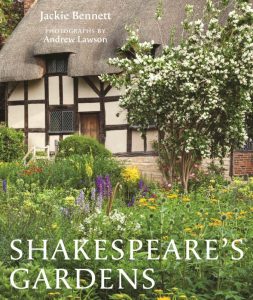Shakespeare’s Gardens
Posted in From the Library on August 4 2016, by Esther Jackson
Esther Jackson is the Public Services Librarian at NYBG’s LuEsther T. Mertz Library where she manages Reference and Circulation services and oversees the Plant Information Office. She spends much of her time assisting researchers, providing instruction related to library resources, and collaborating with NYBG staff on various projects related to Garden initiatives and events.
 This year marks the 400th anniversary of the death of William Shakespeare in 1616. Throughout the world, scholars and institutions have been celebrating the bard’s life and work—including the World Shakespeare Congress held in Stratford-Upon-Avon and London last week and this week. On an appropriately literary note, one of the books about Shakespeare that has been published in 2016 comes from Jackie Bennett and the Shakespeare Birthplace Trust. That book is Shakespeare’s Gardens.
This year marks the 400th anniversary of the death of William Shakespeare in 1616. Throughout the world, scholars and institutions have been celebrating the bard’s life and work—including the World Shakespeare Congress held in Stratford-Upon-Avon and London last week and this week. On an appropriately literary note, one of the books about Shakespeare that has been published in 2016 comes from Jackie Bennett and the Shakespeare Birthplace Trust. That book is Shakespeare’s Gardens.
Shakespeare and his usage of plants in his works is a popular topic in botanical and garden history. In fact, the NYBG Mertz Library has over thirty books related to the playwright. The earliest, The plant-lore & garden-craft of Shakespeare by Henry N. Ellacombe, was published in 1884. With such a rich legacy of books on this topic, the question becomes what another publication could add to the corpus.
As it turns out, Shakespeare’s Gardens more than holds its own. It’s a lovely book sure to delight historians and garden enthusiasts alike. The book features seven locations of historic significance in Shakespeare’s life, including five Stratford-Upon-Avon gardens. Each section includes biographical information about Shakespeare, as well as historic information about the garden site, and information about the garden today. The text is liberally supplemented with beautiful photographs of the different sites and gardens taken by Andrew Lawson. Images range from landscape shots of the gardens to beauty shots of individual plants.
In addition to the biographical information and site histories, each section of the book contains a two-page profile for plants featured in Shakespeare’s work. For example, the chapter “The Stratford Boy” features information about daffodils, including etymology and symbolism. These plant profiles are accompanied by beautiful hand-colored woodcuts from the 1597 publication Herball by John Gerard. Images from Herball, along with many other historic images used in the book, come from the Shakespeare Birthplace Trust. Working in a library with extensive special collections, I would have loved to see more precise image credits and citations alongside the images in the text, but perhaps such a presentation would have been considered too busy for this book.
One thing that readers should be aware of is that this book is not intended as a how-to for gardeners hoping to create a Shakespeare Garden at home. Plant lists are provided in places, but accompany landscape photographs that may or may not include all of the plants listed, acting more as illustrative examples as opposed to explicit planting instruction or design. This does not detract from the reading in any way, but it is something to keep in mind. Home gardeners who do wish to create a Shakespeare Garden may wish to refer to this NYBG Plant Information Office how-to guide on the topic.
All in all, Shakespeare’s Garden has a wonderful flow, and strikes a lovely balance between written word and beautiful imagery. While not everyone can visit the UK for the 400th anniversary festivities, sitting down with a copy of Shakespeare’s Gardens offers a wonderful journey of its very own.
Shakespeare’s Gardens. Jackie Bennett (author) & Andrew Lawson (photographer). Frances Lincoln, 2016. 192 pages. Hardcover. $40.00. ISBN: 9780711237261

